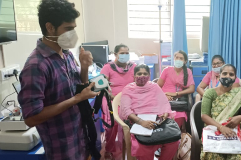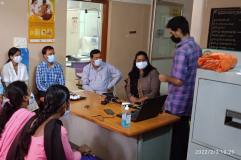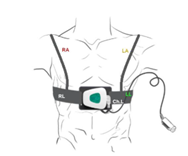Cardiac Design Labs
Telemetric Patient Monitoring System


CURRENT IMPACT
As of August 2023
700 +
Devices deployed in different states
32
devices deployed in 8 Composite Hospitals of Border Security Forces (BSF)
6200+
patients directly monitored using Padma Vitals devices

Geographical Focus
- PAN India

Potential Impact
-
Reach
200,000
lives


SAMRIDH has been a key partner in our efforts to scale-up Padma Vitals across the length and breadth of India, particularly to enhance its access for vulnerable communities. The support received through the initiative enabled us in timely deployment of Padma Vitals devices and improvement in the product outreach. This collaboration has set us on the path to achieve financial sustainability in the long run.

Samridh support
SAMRIDH’s financial assistance is enabling CDL to manufacture and deploy 2,500 Padma Vitals / Padma Rhythms devices at district level hospitals, community health centers, and primary health centers. The enhanced sales have helped CDL to generate the required cash flows to support its operations and manufacture additional devices that will be deployed in hospitals located in tier 2 and 3 cities. SAMRIDH has further been catalytic in augmenting CDL’s business capabilities by strengthening its marketing and sales effort towards reaching out to potential partners and customers for demos and trials. This has led CDL to achieve a leverage of 11.9x on the financial assistance received from SAMRIDH. In addition, SAMRIDH has also supported CDL through different business advisory services which led to better positioning of their devices in different markets and further market penetration of the product in unique and remote geographies.


Hospitals in semi urban and rural regions of India are invariably under-resourced and lack access to sophisticated medical equipment and devices to monitor vitals of patients suffering from serious ailments. Additionally, they do not have trained staff to interpret readings and data that can enable them to make informed decisions about patients. The COVID-19 pandemic exacerbated these challenges and created a demand for reliable remote monitoring systems that would minimize the risk of exposure to the coronavirus and allow medical specialists to monitor multiple patients simultaneously from anywhere in the world.
Padma Vitals

Padma Rhythms
Padma Rhythms is a long-term cardiac monitoring device that helps diagnose cardiac rhythm problems earlier than they become acute. It is a five-day test that works by transmitting the data through the patient’s phone and with the help of in-house developed algorithms, remote monitoring of the patient is achieved and with data analysis the hospitals find it convenient to scale it up, to address the COVID-19 challenges in India. The Padma Rhythms Patch is designed with the best bio-materials from the world to make it comfortable for the patient to wear and last the test duration under normal use. This test is enabled with state-of-the-art electronics, connectivity software and algorithms to actively manage and report the ECG data in a timely manner.Key Stakeholders


